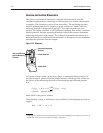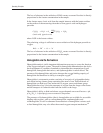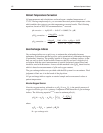
IĆ26 800 Series Operator's Manual
where pK, which is the dissociation constant describing the ability to release
hydrogen ions
, equals 6.105 for normal plasma, and 0.0307 is a combination of
CO
2
solubility in plasma and a factor for converting mmHg to mmol/L.
The equation can be further developed to show pH as proportional to the acid-base
relationship:
pH T
HCO
3
–
H
2
CO
3
The equation clearly demonstrates the HCO
3
–
, pH relationship. As HCO
3
–
increases the pH increases, and as HCO
3
–
decreases the pH decreases.
21
The kidneys are the major controller of the bicarbonate ion. Bicarbonate levels are
clinically significant in helping to determine the non-respiratory, renal (metabolic)
component in acid-base disorders.
Changes in HCO
3
–
levels along with pH values can help determine whether
acidosis and alkalosis disorders are metabolic in origin. In metabolic acidosis,
HCO
3
–
levels decrease causing an increase in H
+
which leads to a decrease in pH.
Conversely, in metabolic alkalosis, HCO
3
–
levels increase, causing a decrease in
H
+
, which leads to an increase in pH.
There are two versions of bicarbonate, the actual value and the standard value. The
800 system lets you select the bicarbonate equations to apply to patient results. You
can select the equation for actual bicarbonate, standard bicarbonate, or both.
A ctual Bicarbonate (HCO
3
-
act)
Solving the Henderson-Hasselbalch equation for bicarbonate ion concentration
results in the following equation, which is based on the National Committee for
Clinical Laboratory Standards (NCCLS) recommendations,
32
for actual
bicarbonate:
log cHCO
3
–
= pH + log (pCO
2
× 0.0307) – 6.105
Standard Bicarbonate (HCO
3
-
std)
The equation described by VanSlyke and Cullin
23
is used for calculating standard
bicarbonate:
[HCO
3
–
] = 24.5 + 0.9A + (A – 2.9)
2
(2.65 + 0.31ctHb)/1000
where
A = BE(B) – 0.2 [ctHb] [100 – O
2
SAT]/100
The ctHb value can be entered during sample analysis or it can be a value defined
in setup.


















